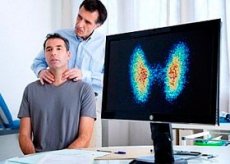Medical expert of the article
New publications
Diagnosis of hypothyroidism
Last reviewed: 04.07.2025

All iLive content is medically reviewed or fact checked to ensure as much factual accuracy as possible.
We have strict sourcing guidelines and only link to reputable media sites, academic research institutions and, whenever possible, medically peer reviewed studies. Note that the numbers in parentheses ([1], [2], etc.) are clickable links to these studies.
If you feel that any of our content is inaccurate, out-of-date, or otherwise questionable, please select it and press Ctrl + Enter.

Diagnosis of severe forms of hypothyroidism, especially in people who have undergone thyroid surgery or received radioactive iodine treatment, which caused autoimmune diseases, does not cause any particular difficulties. It is more difficult to identify mild forms with scanty, not always typical clinical symptoms, especially in elderly patients, where it is easy to suspect cardiovascular insufficiency, kidney disease, etc. In young and middle-aged women, a number of symptoms similar to hypothyroidism are observed in the syndrome of "idiopathic" edema.
The diagnosis of primary hypothyroidism is specified by a number of diagnostic laboratory studies. Functional thyroid insufficiency is characterized by a decrease in the blood level of protein-bound iodine - BBI, butanol-extractable iodine and the degree of 131 I absorption by the thyroid gland, mainly after 24-72 hours (with a norm of 25-50% of the administered dose). However, these indicators are not always adequate to the clinical symptoms and are not absolutely informative. The use of the 131 I absorption test by the thyroid gland is practically more appropriate for detecting hyper-, rather than hypothyroidism.
In recent years, it has become possible to directly determine TSH, as well as T3 and T4, in the blood using a radioimmune method using commercial kits.
The greatest diagnostic value in hypothyroidism is the determination of TSH, the level of which increases significantly (sometimes tens of times), and the calculation of the free thyroxine index.
Thyrotropin-releasing hormone TRH was the first hormone to be isolated from the hypothalamus and then synthesized. Intravenous administration of 200 μg of the drug to healthy individuals results in the maximum increase in blood TSH concentration after 15-30 minutes, and thyroid hormones after 90-120 minutes. The most reliable increase in all values occurs after 24 hours. An increase in TSH concentration over 25 mcg/ml after 15-30 minutes of administration of 200 μg TRH indicates a hyperergic reaction, which is observed when latent "preclinical" hypothyroidism is detected. In primary hypothyroidism, especially in Van Wyck-Hennes-Ross syndrome, the prolactin content in the blood also increases, which requires differential diagnosis with Chiari-Frommel syndrome (occurs after childbirth) and Forbes-Albright syndrome (caused by pituitary adenoma).
In secondary hypothyroidism, the content of SBI and the absorption of 131 I are reduced, but the results of the test with intramuscular injection of TSH show that, unlike in primary hypothyroidism, they increase. The initial content of TSH is reduced, and in the test with TRH in patients with the pituitary genesis of the disease, no effect is observed. In hypothalamic forms, when the decrease in TSH is a consequence of the insufficiency of endogenous thyroliberin (tertiary hypothyroidism), the introduction of exogenous thyroliberin can increase the concentration of TSH in the blood, but to a lesser extent than in primary hypothyroidism.
The basal level of prolactin in pituitary forms of secondary hypothyroidism may be normal or decreased, and in response to the introduction of thyrotropin-releasing hormone, its changes are insignificant. In hypothalamic forms, the basal level of prolactin and its response to thyrotropin-releasing hormone are within normal limits. The content of thyroid hormones in the blood is decreased, and in response to stimulation with exogenous TSH by thyrotropin-releasing hormone, it increases. A reliable increase in T3 and T4 is observed 2-4 hours after intravenous administration of TRH.
For practical purposes, additional methods such as determining the time of the Achilles reflex, cholesterol and beta-lipoproteins in the blood, and electrocardiographic examination are used.


 [
[